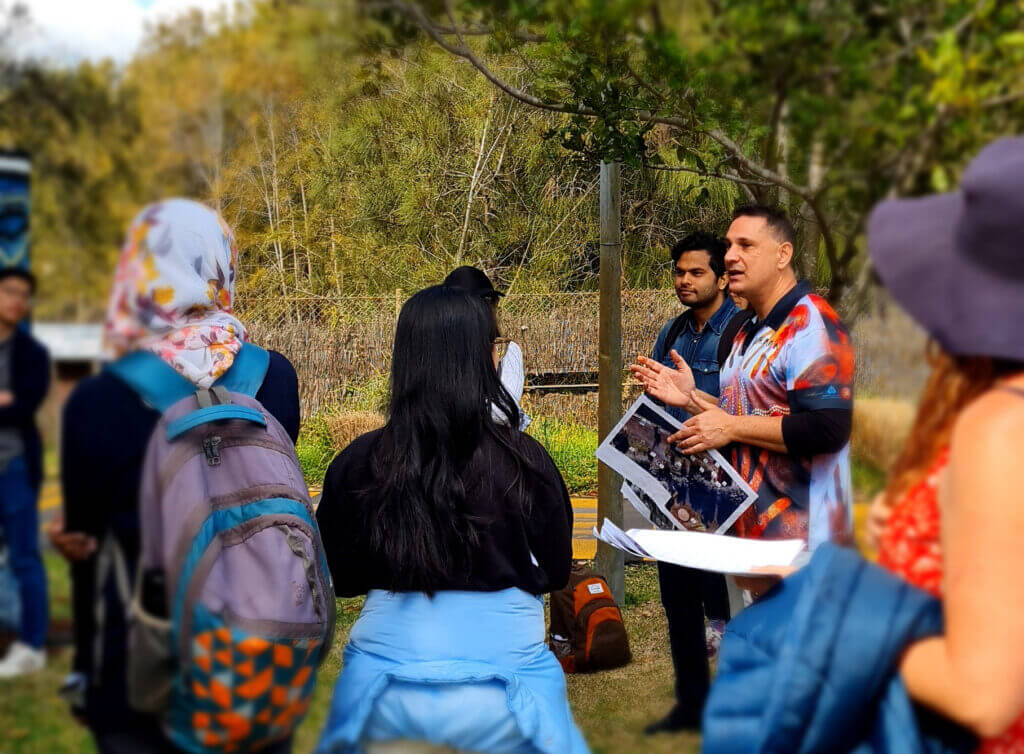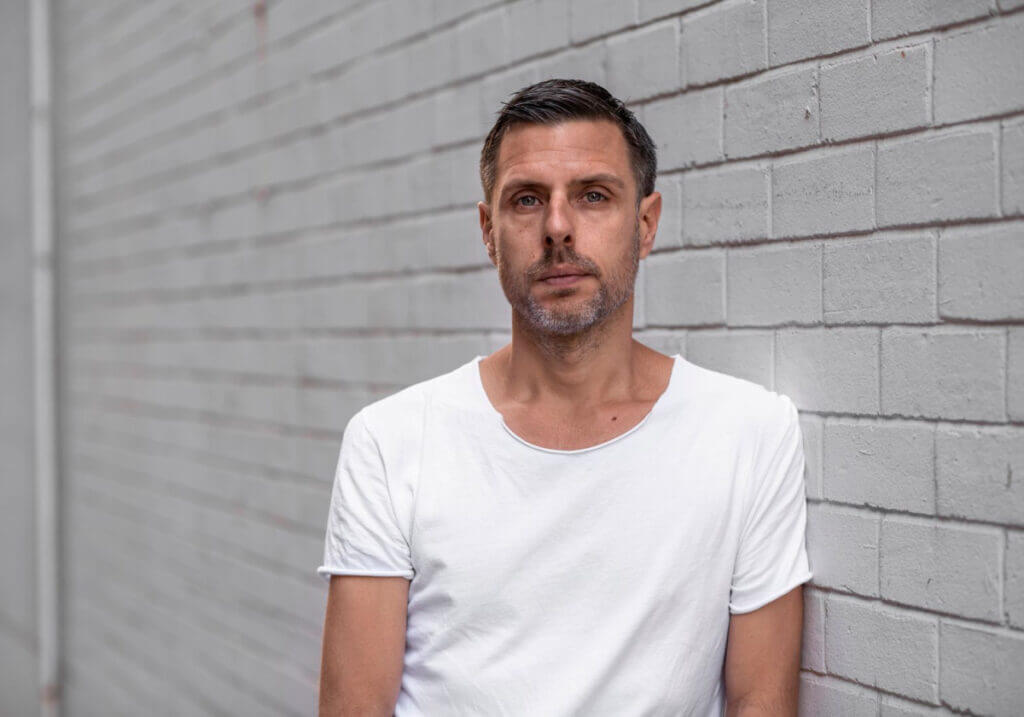
On urban Country learning through field schools and storymaps
by Professor Kate Lloyd & Helga Simon
Fieldwork is a foundational component of any geographic education, supporting students to develop key skills in observation, research design and communication. For the past two years Macquarie University's Geography and Planning Field School has worked closely with Indigenous knowledge holders at Murama Healing Space in Sydney Olympic Park to help students engage with Indigenous knowledge holders, conduct fieldwork and communicate their findings through the digital tool, StoryMap.
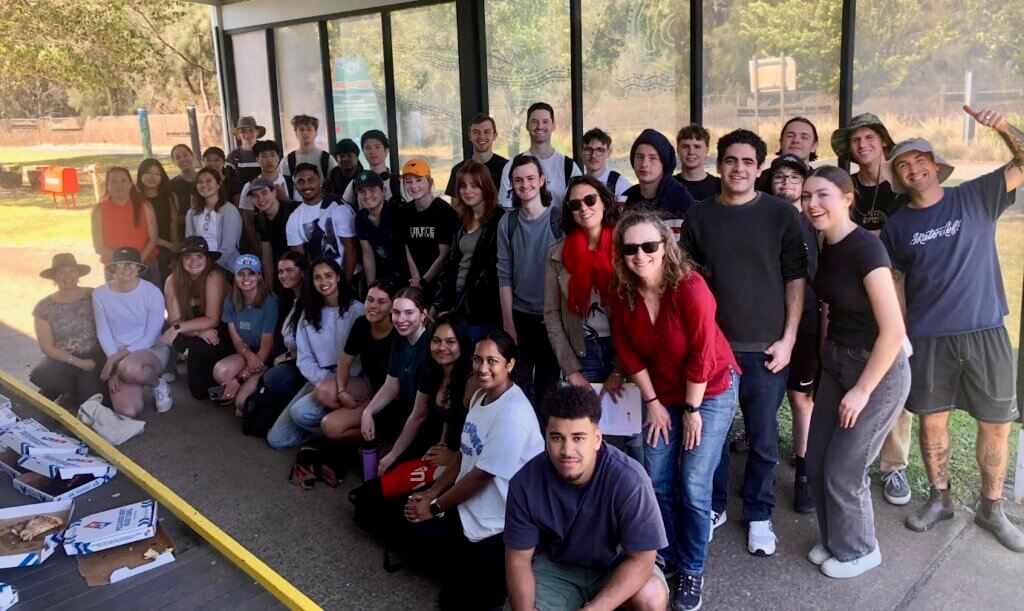
The Geography and Planning Field School is a second-year undergraduate unit that aims to develop comprehensive research skills from defining and planning projects to collecting, analysing, and presenting fieldwork research data. Most students who take this unit are enrolled in a Bachelor of Planning or a Bachelor of Education and are keen to get out of the classroom and into the field, some for the first time. In 2023 and 2024 our teaching team worked closely with Indigenous knowledge holders to support students to visit the Murama Healing Space at Sydney Olympic Park, conduct their fieldwork and communicate findings through the digital tool, storymap.
The Murama Healing Space officially opened in June 2019 in response to a lack of dedicated public spaces where Aboriginal and Torres Strait Islander youth from Western Sydney and beyond can connect with Country and learn culture and language. You can read more about Murama and Sydney Olympic Park Authority's unique Indigenous-led engagement of this public space here.
What does urban Country mean?
In Aboriginal worldviews, everywhere and everything is Country, “a living entity with a yesterday, today and tomorrow, with a consciousness, and a will toward life … Country is not a generalised or undifferentiated type of place,” something ‘over there’ to be drawn or operated on. Rather, it is a concept in which the “values of life are pre-given …” (Rose, 1996, p.7). There is increasing recognition that Country is not a remote or regional place, but cities are also Country. Terms such as ‘urban Country’ and ‘city-as-Country' are making their way into public discourse and highlighting that connecting to Country does not require 'wilderness', the 'Outback' or the 'countryside'; it is possible anywhere.
What makes the Murama Healing Space distinct is the way people who visit learn to connect with Country even on a site with a heavy colonial, industrial, toxic and military legacy. This public space is a site of adaptive re-use that has been both environmentally rehabilitated and has sought to reaffirm Aboriginal presence and heritage. It is a place open to all who wish to learn to connect with Country in the city.

On urban Country learning
In 2024, we wanted students to use the field school as an opportunity to engage with urban Country.
We posed the questions:
- How does Murama Healing Space demonstrate a Country-centred approach?
- How does it align with the Connecting with Country framework?
- How can a Country-centred approach to creating public space lead to increased wellbeing for kin and Country?
Students were introduced to two Indigenous frameworks that have been designed facilitate learning on and from Country:
The Kin & Country (Bishop & Tynan, 2022) Country framework has been devised by two Ab(Original) women, Gamilaroi scholar Michelle Bishop and Pairrebeenne Trawlwoolway scholar Lauren Tynan in response to recognising that there are historical, cultural and personal challenges facing non-Indigenous teachers when incorporating Indigenous ways of knowing into classroom settings. The framework invokes more-than-human agencies as they share teachings and relational perspectives through description of four entities that represent four different perspectives: Eagle, Ant, Grandmother, and Granddaughter. Each perspective performs a different way of knowing.

The Connecting with Country (GANSW, 2023) framework is a guide for built environment professionals to learn and practice what the framework calls “a Country-centred approach”. It sets out “practices for enabling a new approach” fundamental to seeing/thinking/doing planning through an Indigenous lens, providing guidance in shifting from a human-centred to a Country-centred approach. The Indigenous engagement team from GHD, an international planning consultancy, zoomed in to speak with students about the framework and the various ways it was being employed across the state, including at the Western Sydney Aerotropolis.

These frameworks provided our teaching team a way to guide student learning on Indigenous knowledge process. That is, instead of teaching Indigenous content this unit was about teaching students about how knowledge is built, where the how to learn from Country is prioritised over any explicit direct teaching about Country.
Relationships were foundational to the field school and underpinned all learning. Culturally safe knowledge transmission relies on authentic and trusting relationships between non-Indigenous and Indigenous educators. Before taking the field school to Murama Healing Space, our teaching team had developed a strong working relationship with Dr John Hunter, co-founder of the Murama Healing Space. Likewise, our team had worked closely Dr Lauren Tynan, co-author of the Kin & Country framework over several years. As such, we were able to model the ways in which relationships with Indigenous knowledge holders was a fundamental part of any Country-centred approach.
Uncle John and Ayoola Shognule from Murama facilitated the site visits and cultural learning. Lauren introduced the students to the Kin & Country framework. Students were encouraged to ask questions and learn directly from Indigenous knowledge holders. The sharing and learning from both Uncle John and Lauren are generous and generative opportunities for students to develop their learning of and with Country but they are also important for truth-telling and as an act of reconciliation (Rey, Simons).

Photo: Helga Simon
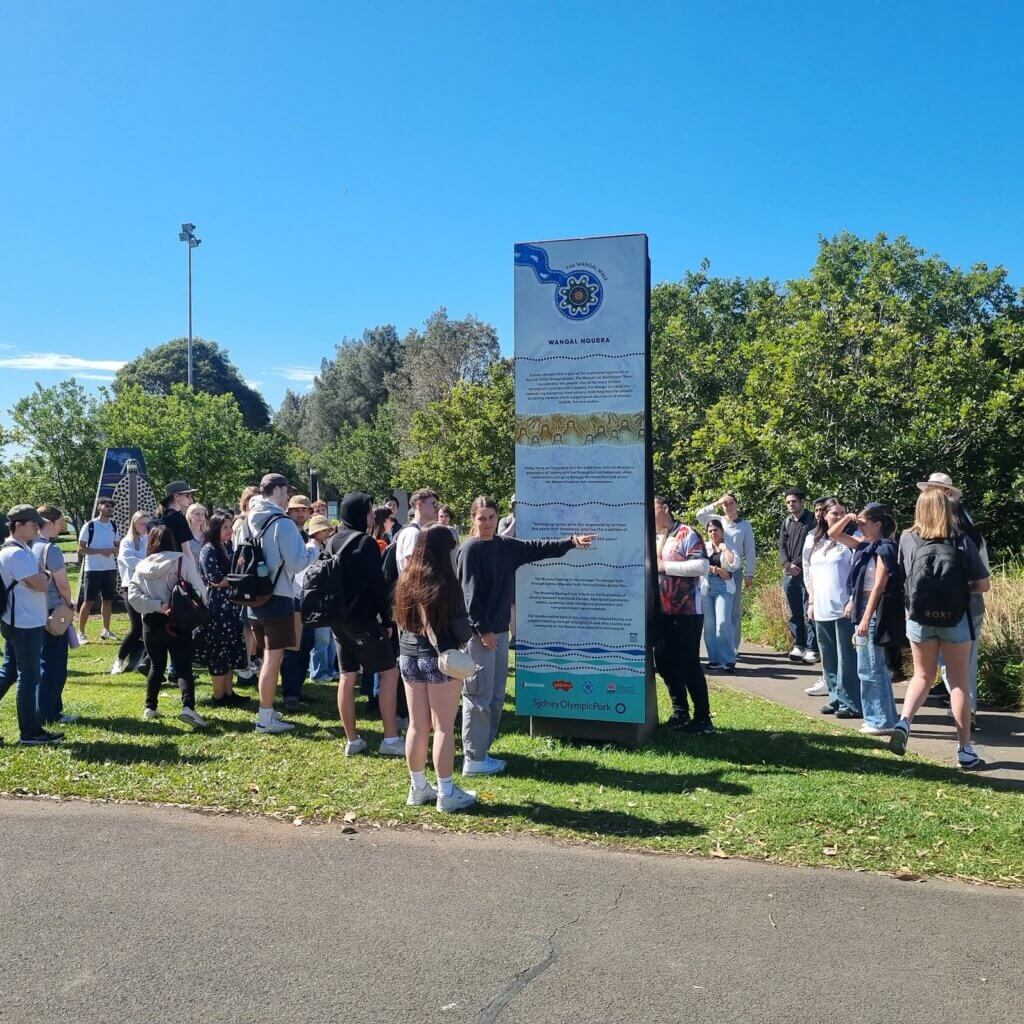
The experience of being on Country is not simply between ‘you’ and ‘Country.’ This would imply that there is a separation between the two. The reality is, it is not actually ‘between’ anything, rather it is connecting with more-than-human (and/or human) kin – much like being part of a family. Through this unit and attending the Murama Healing Space, I have become more acquainted with the concept of connecting and experiencing Country as more than simply the entity in which I exist upon. There is no ‘you’ and ‘Country’ – as really, we too, are Country.
2024 student reflection
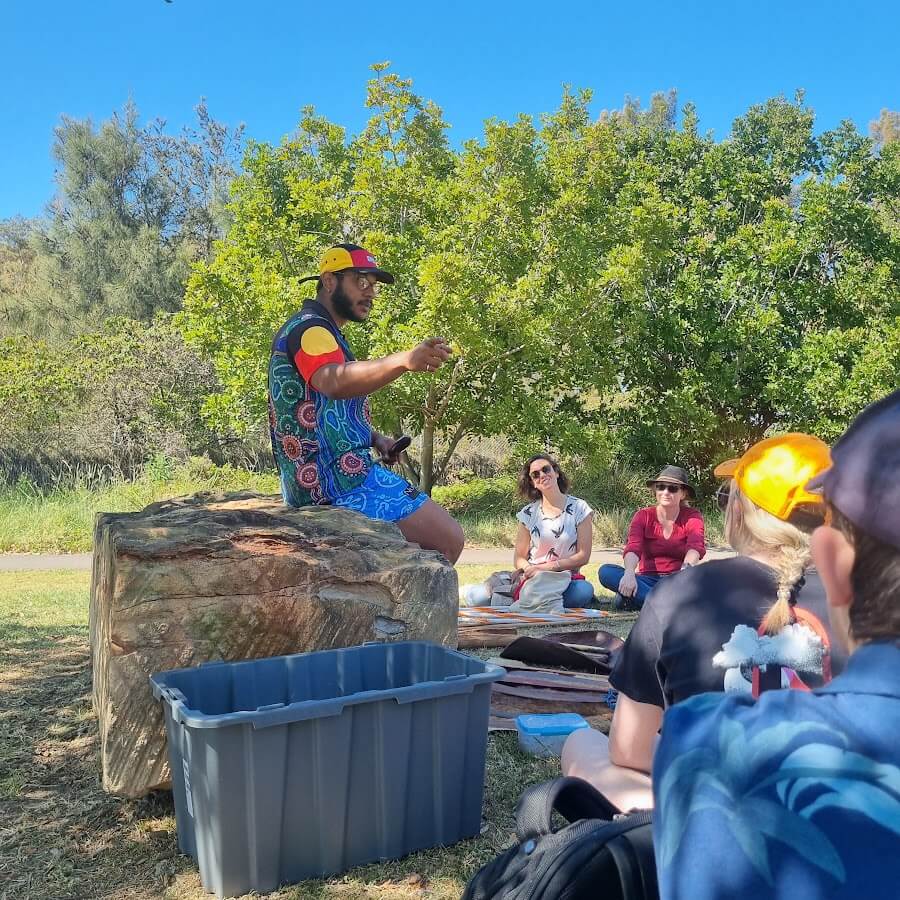
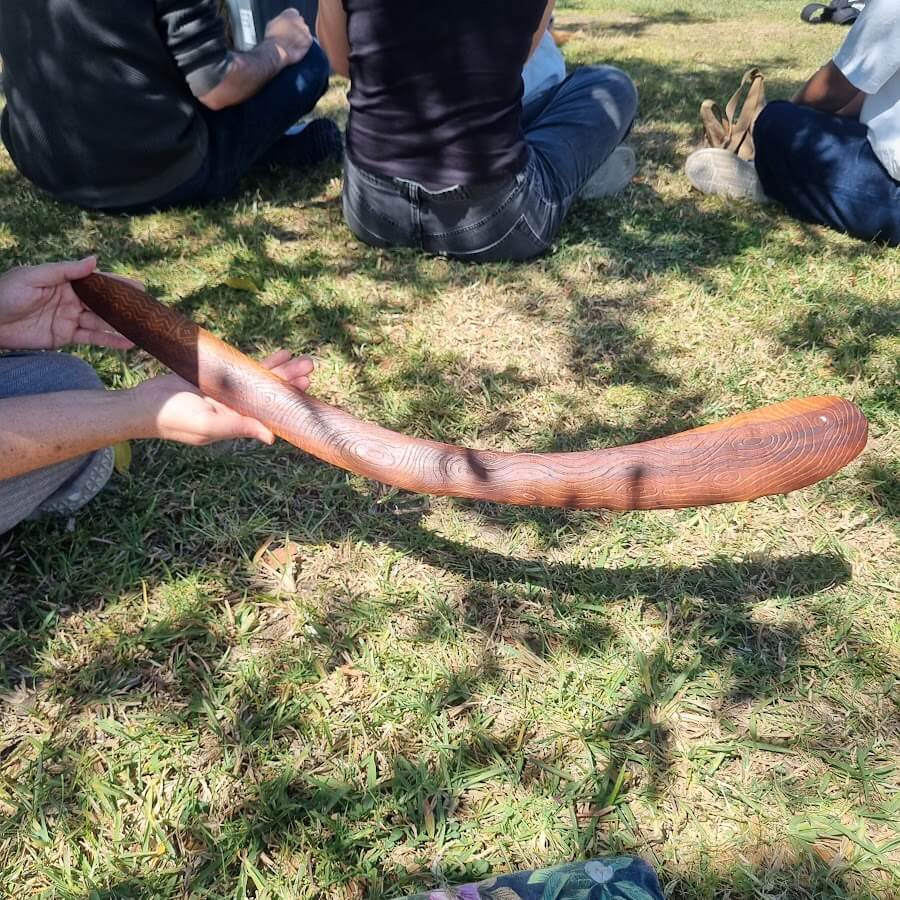
Field school storymaps – what did they do?
Storymaps are digital, interactive storybooks that combine maps, text, images, and multimedia content to tell a compelling story. This form of storying and reflection can be a great way to enhance student learning. Students worked in a group to develop a storymap about Murama Healing Space at Sydney Olympic Park.
Students developed a storymap for selected audiences e.g. planners, teachers, the public, to become more familiar with the practices of communing with, sensing and being on Country. They used framework such as the Connecting with Country framework (GANSW, 2023) and/or Kin & Country framework (Bishop and Tynan 2022) to describe different ways of seeing/thinking/doing and trial different methods of data collection and analysis.
The students' storymaps suggest that being on site, hearing from Uncle John and using the Kin & Country framework were key to understanding the concept of Country and engaging in a Country-centred approach.
On completion of the field school, students reflected upon their learning, citing the time on site, listening to Uncle John and learning through the Kin & Country framework as being the three most powerful elements that helped them develop a Country-centred approach. Given many of them will go on to be the planners and teachers of the future, students reported feeling better equipped to engage Indigenous knowledge and progress in policy and praxis in their professional careers. At a personal level, we hope the unit gave students some understanding and even their own experience of connecting with urban Country.
Explore student storymaps

Murama Healing Space: Engaging with country through sensory methods
Our storymap is designed with five multisensory aspects: sound, sight, thinking, touch, and smell. Every sensory aspect is essential to engage with and interconnect with, and although these are different, they identify with and connect with the Country.

Teaching Teachers: a Country-Centred Framework
Through reflective content and exercises this storymap will endeavour to help teachers convey to their students the essence of Indigenous philosophies, in a manner that we intend will help students critically reflect on and deepen their perceptions and understanding of Indigenous perspectives and philosophies.

Entangled Life: Finding Identity through More-Than-Human Kin - an educators guide
Stage Three children experience multiple developmental changes as they age and subsequently experience impacts on their self-esteem due to the physical and emotional changes happening during puberty. In response to these factors, we created an educator's guide that aims to use place as a pathway to fostering well-being and a stronger sense of identity.

Healing at Sydney Olympic Park - Murama Healing Space
An interactive storymap that connects with Country and encourages healing through listening to its teachings and engaging with culture.
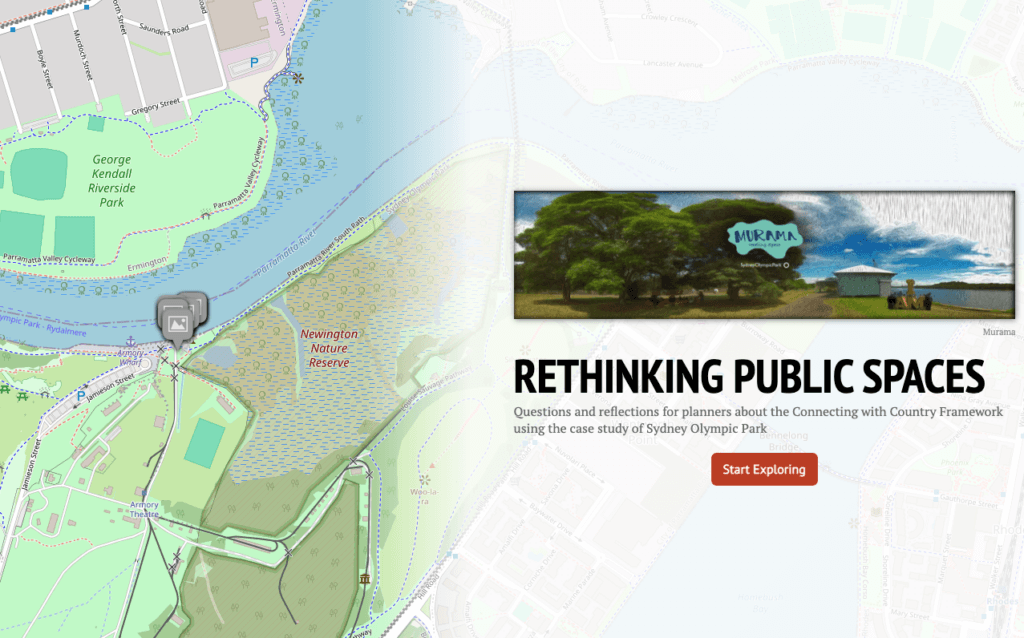
Rethinking Public Spaces - a digital field trip for Planners
This field trip focuses on the co-design of the public spaces in Sydney Olympic Park. It contains questions and reflections for planners about how we can respond to Country using initiatives such as the Connecting with Country Framework, and how we can activate cultural and spiritual aspects of Indigenous Country.
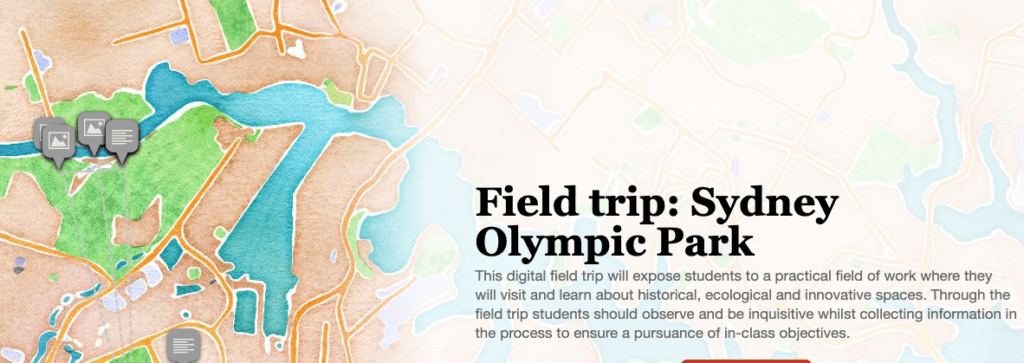
Sydney Olympic Park - a digital field trip for primary school children
This digital field trip is aimed at primary school children and encourages them to consider the historical, ecological and innovative spaces within Sydney Olympic Park. Students will be asked to observe, ask questions and collect information as they make their way through the story map.

An avian guide to Sydney Olympic Park parkland ecology
This storymap integrates cartographic features and points of interest of the local area onto the map's user-interface, requiring viewer/human navigation (zooming in by clicking and panning by dragging with each slide) to fully experience the bird's-eye perspective of our Eastern Curlew narrator.
Header image: detail from Healing at Sydney Park StoryMap
Bishop, M., & Tynan, L. (2022). Finding perspective through our more-than-human kin. In The Routledge Handbook of Global Development (pp. 593-604). https://doi.org/10.4324/9781003017653-57
Bishop, M., & Tynan, L. (2024). Incorporating Indigenous perspectives through the Kin and Country Framework. mETAphor(3).
GANSW, The Government Architect NSW (2023). Connecting with Country framework. Retrieved from https://www.planning.nsw.gov.au/government-architect-nsw/policies-and-frameworks/connecting-with-country
Porter, L. (2018). From an urban country to urban Country: confronting the cult of denial in Australian cities. Australian Geographer, 49(2), 239-246. https://doi.org/10.1080/00049182.2018.1456301
Rey, J. A. (2019). Dharug Custodial Leadership: Uncovering Country in the City. WINHEC: International Journal of Indigenous Education Scholarship, 1, 56-66. https://journals.uvic.ca/index.php/winhec/article/view/18941
Rose, D. B. (1996). Nourishing terrains: Australian Aboriginal views of landscape and wilderness / Deborah Bird Rose. Canberra: Australian Heritage Commission.
